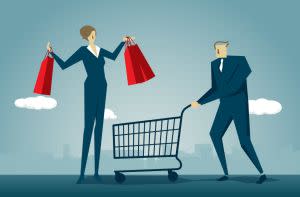Retail and food service sales rose 1.2% in July as store reopenings continued. However, the pickup was much less than the 8.4% rise in June. It was expected that June’s increase would slow as more businesses returned to normal operations, but the surge of the coronavirus in the South and West in July likely also contributed to the slowdown. The largest sales jumps were seen at electronics and appliances stores (+22.9%), miscellaneous (+6.2%), clothing (+5.7%) and restaurants (+5.0%). Both grocery stores and e-commerce sellers held onto their gains, each rising a small amount from an already elevated level. Although sales of cars and building materials declined in July, they remain at elevated levels as well.
Sales are near or above precrisis February levels for most store categories now. After consumers socked away more savings in recent months, they have cash to spend on big-ticket items such as cars and home improvement projects. They are spending more on goods right now than services, so almost all retail sales categories are benefiting. Folks who are staying home instead of going out are buying groceries and sporting goods equipment instead of going to restaurants or gyms.
Sales are still 25% below precrisis levels for clothing stores and restaurants, and 11% for department stores. Clothing and department stores typically depend on the in-store experience to boost sales. Restaurants are slowly figuring out how to operate with precautions, but likely will remain limited in their capacity for some time to come.
Expect goods sales to continue to do well, but there are some headwinds for August. Namely, expanded unemployment payments expired at the end of July. These were an important factor in lifting retail sales after the shutdowns. However, recent reductions in infection rates will likely help persuade shoppers to get out more.
Source: Census Bureau, Retail and Food Service Sales statistics

